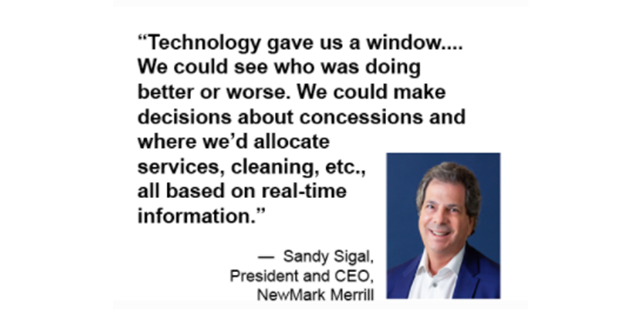“Retail has one very serious advantage as an asset class — it provides a lot of data. However, very few people actually look at the data,” says Sandy Sigal, president and CEO of NewMark Merrill.“
Historically, gathering data required landlords and managers to physically visit sites, and data insights would likely have been skewed based on time of day for the visit, momentary traffic variables or incomplete sales reports. Today’s technology automatically captures much more complete data related to consumer demographics and behavior patterns. For today’s shopping center owners, the challenge isn’t collecting data, it is analyzing the volume of collected data and making it useful for landlords and retail tenants.
Sigal mentions three reliable and sweeping data sources that inform a comprehensive approach to shopping center management, letting landlords and managers react in real time: phone/location analytics data, camera systems and social feeds.
Location Analytics via Phones
Sigal uses a location analytics software (specifically, Placer.ai) that gives insight into foot traffic and customer journeys, collecting the data consumers choose to share through their phones. Randomized and anonymized phone data lets NewMark Merrill know who’s coming into a center, who’s leaving and where they are shopping.
Phone data also gives a clear picture of how customers are arriving at shopping centers. During COVID — as customers shifted to working from home — Sigal noted that the data indicated that 90 percent of retail center traffic was coming from homes to shopping centers, and not from offices to shopping centers, as had previously been the case. The change was apparent “almost overnight,” he says.
Camera Systems
Data from camera feeds help NewMark Merrill anticipate or pinpoint problems at the store level. For example, long lines, ongoing failures to wear masks during mask mandates and unappealing clutter in front of stores have all served as cues for NewMark Merrill to speak to tenants and help them improve.
Social Feeds
NewMark Merrill also collects online feedback from sources like Google, Facebook, Yelp and TripAdvisor to pinpoint negative feedback in real time.
“Our job as a landlord is to provide an environment where our shoppers felt connected, safe and encouraged to shop. In this way, customers choose to shop at our centers versus alternatives — which includes not only other shopping centers but also staying at home or shopping online.”
The ability to react to negative interactions and improve by collecting trend-indicating data means that NewMark Merrill can share this data with their tenants quickly and dispassionately.
Avoiding Information Overload
“There’s a swing that’s happened in technology,” Sigal says. “Even three years ago, there were relatively few technology products in each category. Today, that’s not the problem. There’s tons of technology products and a lot of categories. Buying is easy part.”
He adds, “Now you’ve gone from having no data to having tons of data. The hard part is getting the team to use the technology and getting the data in the right people’s hands. It is hard to have the data both usable and integrated. The question becomes, how do you parse it? Visualization makes it a lot easier.”
To avoid drowning in data, Sigal’s teams worked with their information providers to obtain simplified versions of the data that include visualizations to track trends. A task force goes through what they’ve learned from the data, and then their activations from those learnings. “Then we put together a protocol,” he explains. “We have a procedure: if these are the facts we’re seeing from the data, here’s how we act to address that in real time.”
These protocols influenced every aspect of NewMark Merrill’s COVID policies. For example, where to put stickers and signage, how to communicate rules for spacing, as well as cleaning station placement. New protocols meant working with security teams to “rebrand.” Security personnel were no longer primarily concerned with shoplifting or safety in a traditional sense. Employees received training on how to make customers feel safe from COVID by providing masks or hand sanitizer, as well as helping avoid customer bottlenecks.
Communicating Data to Tenants and Consumers
Sigal stays in close contact with his tenants via channels like weekly emails and phone calls; and he warns tenants as real-time negative comments come to him via property managers.
NewMark Merrill also used data to determine how to handle rent concessions, deferrals and help on PPP during the pandemic. “With COVID, some stores were required to shut down, some stores could only operate through delivery and drive-through and some tenants were open (although maybe with restricted hours),” elaborates Sigal. “Technology gave us a window into those varying situations, and we could tell immediately the changes in traffic to stores. We could see in real time who was doing better or worse. We could make decisions about concessions and where we’d allocate services, cleaning, etc., all based on real-time information.”
Sigal explains what can be gained from these innovations in how technology is used. “Today it is fashionable to be in property technology (proptech). But the real opportunity is to have our community centers really be a part of the community, by knowing more about the people they serve. There is lots of ‘interesting’ data, but like the ‘discovery’ that customers like experiences, knowing how our merchants touch our customers, knowing why and where they come from and when and how long they stay, we can make sure we staff, invest and ensure our retailers have the best chance of achieving the American Dream. And when they succeed, our centers stay leased, our incomes grow, and the value of properties outpace those who don’t know how to use these tools. In the battle for the hearts of our merchants, the implementation and understanding of good data will be a game changer for the shopping center business.”
By shoppingcenterbusiness.com. Click here to read the full article.
